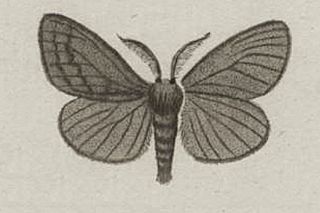
The November moth is a moth of the family Geometridae. The species was first described by Michael Denis and Ignaz Schiffermüller in 1775. It can be found in the Palearctic realm in western Europe from central Scandinavia to the Mediterranean the Caucasus and western Russia.

The scalloped oak is a moth of the family Geometridae. The species was first described by Carl Linnaeus in his 1758 10th edition of Systema Naturae.

The mottled umber is a moth of the family Geometridae. It is common throughout much of the Palearctic region. The species was first described by Carl Alexander Clerck in 1759.

The mottled beauty is a moth of the family Geometridae. The species was first described by Carl Linnaeus in his 1758 10th edition of Systema Naturae.

Mimas tiliae, the lime hawk-moth, is a moth of the family Sphingidae. It is found throughout the Palearctic region and the Near East, and has also been identified in eastern Canada. The species was first described by Carl Linnaeus in his 1758 10th edition of Systema Naturae.

The grey dagger is a moth of the family Noctuidae.

The lobster moth, also known as lobster prominent, is a moth from the family Notodontidae. The species was first described by Carl Linnaeus in his 10th edition of Systema Naturae. The English name refers to the crustacean-like appearance of the caterpillar.

The Sprawler(Asteroscopus sphinx) is a moth of the family Noctuoidea. It is found throughout western Europe, but is mainly a Northern species occurring South to Northern Spain the southern edge of the Alps, Central Italy and Northern Greece. North to southern Sweden. East to Kaliningrad and Moscow. Also in Central Europe, Turkey, the Caucasus and Asia Minor.

Ypsolopha ustella, the variable ypsolopha moth, is a moth of the family Ypsolophidae. It is found in most of Europe and is also present in North America.

Cissusa is a genus of moths in the family Erebidae.

Tischeria dodonea is a moth of the family Tischeriidae. It is found from Fennoscandia to the Pyrenees, Italy and Romania and from Ireland to Ukraine. There is a disjunct population in eastern Russia.

Stigmella ruficapitella is a moth of the family Nepticulidae. It is found in northern and central Europe. It is mostly absent in the Mediterranean region, with the exception of Mount Olympus in Greece and Trieste. It has recently been recorded from Russia and Bosnia.

The European oak leaf-miner or Zeller's midget is a moth of the family Gracillariidae. It is found in Europe south of the line running from Ireland, through Great Britain, Denmark to Ukraine. It is also found in Macaronesia. It is an introduced species in New Zealand and Australia.

Choristoneura fractivittana, the broken-banded leafroller or dark-banded fireworm, is a moth of the family Tortricidae.

Tortricodes alternella is a species of moth of the family Tortricidae. It is found in most of Europe, except most of the Balkan Peninsula.

Cyclophora dataria is a moth in the family Geometridae. It is found in North America, from British Columbia to California, east to Arizona and north to Montana. The habitat consists of mixed or deciduous woods with Quercus species.

Ocneria detrita is a moth of the subfamily Lymantriinae. The species was first described by Eugenius Johann Christoph Esper in 1785. It is found in France, Italy and parts of central, south-east and eastern Europe.
Cissusa mucronata is a moth of the family Erebidae. It is found in North America, where it has been recorded from Arizona and Texas.
Cissusa valens, the vigorous cissusa moth, is a species of moth in the family Erebidae. It is found in North America, where it has been recorded from Utah east to Colorado, south to western Texas and west to Arizona.
Chionodes trichostola is a moth in the family Gelechiidae. It is found in North America, where it has been recorded from south-western British Columbia to California, Utah, Colorado, Arizona and Texas.















